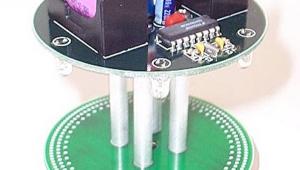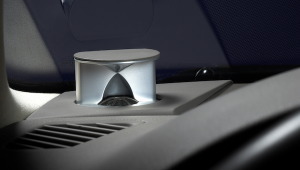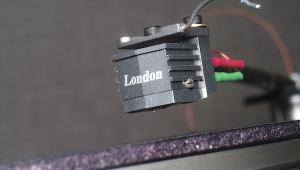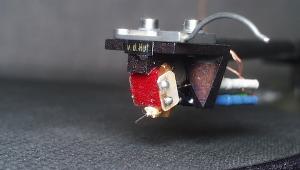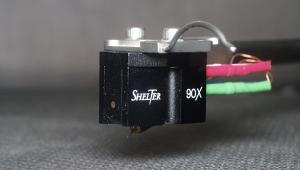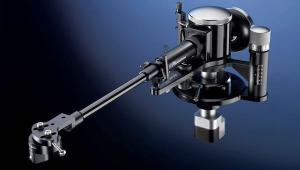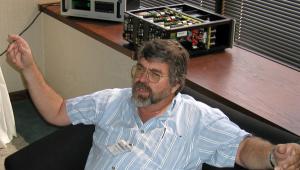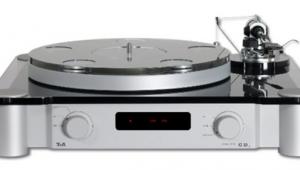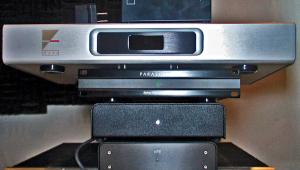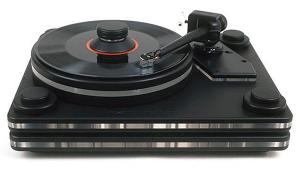Analog Corner #94
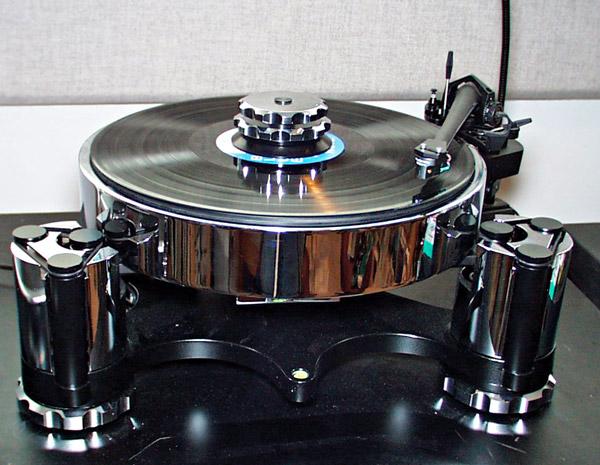
Other folks have taken advantage of Rega's popularity as a high-volume manufacturer of integrated turntables and OEM tonearms, making and marketing such enhancements as replacement arm counterweights. Riding the counterweight on a pair of O-rings, as Rega does in its RB300, RB600, RB900, and RB1000 arms, makes little sense to me theoretically or, after trying two aftermarket counterweights, sonically. Why? the O-rings are, essentially, springs. The ones in the Rega counterweight are compressed and probably have a resonant frequency in the audioband, or at least somewhere they do no good. They certainly don't "decouple" the weight from the arm. That would require a resonant frequency well below the audioband—at, say, 3Hz.
Expressimo Audio and Kerry Audio Design make replacement Rega counterweights. Gregory Kerry sent me his F2 Titanium ($129 factory-direct from gkerry@sympatico.ca), and Expressimo Audio's Sal Calaio sent me his stainless-steel Heavyweight ($89.95, www.expressimoaudio.com). Both offset the hole for the armtube so the mass of the counterweight hangs below the pivot point for greater claimed stability and tracking prowess, and both are claimed to "decouple" the counterweight; that is, move its mass-compliance resonant frequency below the audioband.
Neither does. Expressimo uses a hard Delrin insert between the armtube and the counterweight, while Kerry's weight is machined with three sets of thin contact rails that ride on the Rega arm's counterweight stub. Without any compliance, how can either design possibly decouple the weight? Kerry's design no more "decouples" the weight than resting your preamplifier on cones "decouples" it from your stand. Same with Expressimo's Delrin insert, which can act as a "filter" but not as a true decoupler.
In any case, Kerry's counterweight is machined from solid titanium, Expressimo's from stainless steel. Titanium is less dense, so the F2 Titanium is much larger than the Heavyweight. Again, I don't know why a lighter material is preferable. Each designer will make claims for the superiority of his design, but please read with your brain engaged. Both are much higher in mass than Rega's original part, which means that in most cases balance will be achieved with the weight much closer to the pivot point—a very good thing. Don't worry if you can't achieve balance with the weight all the way forward: just apply the necessary force using the arm's built-in VTF spring, and set the counterforce using an outboard gauge, which will be more accurate anyway. If balance can be achieved, forget about the spring try using the weight to set VTF, which some listeners claim sounds better.
The sonic improvement these two relatively inexpensive accessories made to the RB300's low-frequency performance was not subtle: it was amazing (probably because neither rests on a high-frequency spring). If you want much better bass response from your system, greater low-frequency extension and control, and a much-improved sense of overall "weight" and tonal richness, try one of these. They both worked well—I wouldn't want to identify which was which in a double-blind test, but I'd have no trouble distinguishing either from the stock Rega.
Expressimo also sent two replacement Rega stubs that are said to offer sonic and mechanical advantages. (You'll need one if you want to replace the counterweight on an RB250, which has a plastic stub.) But the arm I was using wasn't mine; I didn't want to risk ruining the stock part in trying to get it off. Visit Expressimo's website for many more Rega options, including a drop-in threaded VTA adjuster—not the most convenient, but no drilling necessary.
Why not just change arms?
Graham Engineering's Robin tonearm ($795, reviewed by Art Dudley in April, p.121) has been designed to drop into a standard Rega mounting hole, using a base plate that permits spring-loaded VTA adjustability. Raise or lower the arm height, find the VTA sweet spot, then lock it down. The arm can also be fitted to a mount identical to the Graham 2.2's. That way, you can get your dream turntable and have it drilled for the 2.2, but save a few thousand by buying the Robin now, and switching when you can afford to.
The Robin is based on the very familiar PT6 design, made in Japan and long marketed by AudioQuest. Graham's edition uses a much heavier bearing housing, the "best" gimbaled bearings he could obtain, a redesigned pivot assembly, a specially damped armtube, and a removable headshell that takes advantage of the Graham 2.2's ingenious alignment system (available as option).
I dropped the Robin into the Rega P3 I've had on hand for a few months and installed the Sumiko Blue Point cartridge I'd had on the RB300. No, it makes no sense to put a $795 arm on a $750 turntable, and I can't say I heard an improvement over the RB300 in this application. The Graham arm allowed for easy VTA adjustability and sounded different, but not necessarily better. The Robin had an open, airy, effervescent sound that I preferred in some ways to the RB300, but the RB300 (with replacement counterweight) had greater solidity and punch. When I get back to my Simon Yorke turntable, I'll drop the Robin in the 2.2 slot and do a more serious evaluation.
Avid Acutus turntable
I first spotted this chrome-trimmed beauty in the UK a few years ago, when Avid still had no American importer. The opportunity to review it finally arose last January, right after CES, and while I still had the SME 30/2 turntable. The $10,000 Acutus is every bit as deserving of a full review as the 30/2—I review it in "Analog Corner" only because this is my best chance of getting a review into print so soon after my March 2003 report on the SME.
Avid's Conrad Mas claims to have begun designing the Acutus with a "blank slate," but the final product bears some similarities to other 'tables. That's not surprising: LP playback has a specific goal, and there are only so many ways of correctly achieving it (although many misguided attempts have yielded "unique" designs). Superficially at least, the Acutus resembles an Oracle Delphi on steroids. At this point in reading my review, Mas is probably picking up sharp objects to throw. Fortunately, he's on the other side of the pond.
The Delphi and Acutus both have three-point, spring-suspended subchassis, but their executions of this are so different that there's no point in further comparing them. The Acutus consists of three basic building blocks: a main chassis that includes the three spring-suspension towers, a one-piece cast-aluminum subchassis that holds the main bearing/platter assembly and arm mount, and the motor/power supply.
While the entire design holds interest, key is the complex cast-aluminum subchassis, which holds a 16mm spindle shaft of tapered, hardened steel with a recessed tip. The subchassis is fitted with the three suspension points and includes the integral arm-mounting platform. There is no armboard. V-shaped folds in the subchassis casting and other aspects of the casting increase rigidity at crucial places, including the arm-mounting platform interface and the three suspension points. The absence of parallel edges eliminates standing waves. The bottom line is an energy-dissipating platform that is extremely rigid but not critically damped. Mas claims that the more rigid an object, the more difficult it is to damp, so aiming for rigidity and damping is contradictory.
The Acutus's inverted bearing consists of a 4mm tungsten-carbide ball that sits in a well atop the spindle shaft, and a robust, tapered main bearing assembly fitted with a sapphire cup and self-lubricating bushing. The 22-lb aluminum platter includes an integral bonded polymer mat and a uniquely implemented system of threaded clamp and record spindle. The bottom side of the platter features a deep, wide cutout to accommodate the motor spindle-pulley assembly, which protrudes beyond the platter's lower rim. The circular motor casing nestles into a semicircular cutout on the side of the main chassis, held in place by a thick rubber O-ring. The drive belt rides on the inner wall of the cutout.
Setup was relatively easy; if you have nightmares about spring-tensioning and a pitching, rocking subchassis, fear not: this design ingeniously eliminates all of that. Still, once you've assembled the 'table and arm, you have to be able to access the underside of each tower to adjust the spring assembly height until its circular top cap is parallel with the two atop the tower. You then place an O-ring around the three black caps on each tower, which eliminates unwanted lateral motion. The three lateral-damping O-rings are at the same height as the drive belt, so the belt's never going to slip off due to subchassis pitching motion.
When I gently pushed down on the platter, it slowly bounced a few times, then smoothly settled. Because of the combination of springs, O-ring lateral damping, and high-mass platter and subchassis, the system's frequency is an ideal 2.5Hz (approximately) vertically, 4.5Hz laterally.
Drive is applied by a high-torque, hand-built, AC synchronous motor said to be 10 times more powerful than what's used in most turntables, and powered by a split-phase, quartz-locked motor controller with no provision for speed trim. Careful motor design, a round belt, and the motor controller are said to eliminate vibrational and/or cogging effects.
The theory behind all of this is to allow vibrational energy at the stylus/record interface to be quickly and efficiently transmitted to the main bearing and then to the subchassis, where, much like an electrical "diode," it can't travel back in the other direction. The inverted bearing puts its contact point close to the playing surface (4mm) for more efficient energy dissipation, and it lowers the system's center of gravity for greater stability. (Detractors would say that putting the contact point this close to the stylus/groove interface ups the level of bearing noise.) At the same time, energy traveling in the other direction, from the stylus and up the armtube into the base, also drains into the subchassis, which uses its weakest points to dissipate the energy as heat. At least, that's the theory. The only purpose of the base and suspension system is to isolate the subchassis from the outside world.
What you end up with is an extremely compact, heavy, superbly isolated record-playback system. Like the SME 30/2, which I reviewed in the March issue, the Avid Acutus is a "no-BS, industrial grade turntable" with a "truly effective isolation system." While the Acutus' execution differs, its basic design concept is similar to the SME's. The biggest difference is in overall mass, and what you do with the energy: damp it out (SME) or let it dissipate (Avid). The SME is a high-mass, damped design, the Avid a medium-mass, undamped one, though the Acutus' platter is actually heavier.
What impressed me most about the Acutus was how well-thought-out and compact it is; how everything fits together so neatly. It's also handsome, far more so than the SME 30/2. But if looks are important to you, get out the chrome polish, as the platter's outer rim will soon be covered with greasy adult stuff! The overall fit'n'finish of the Acutus is very high, but not in the same league as that of the 30/2, which costs more than twice as much. Most disappointing was the lack of smoothness and consistency to the chromed platter side-wall. When the platter spins, lumps and bumps reflect unevenly across its surface. That aside, the Avid is one dramatic-looking turntable.
Using the Acutus: While the Avid Acutus needs no additional isolation, with Conrad Mas's permission I placed it atop the Vibraplane support and used the supplied SME V tonearm. The subchassis casting is made for the SME V, and while you can use optional adapters for other arms, it seemed to me that doing so would reduce the rigidity and integrity of Mas's subchassis/arm interface scheme.
Using the SME V made it relatively easy to compare the SME 30/2 and the Avid Acutus. I first removed the SME V from the Acutus and replaced it with the SME IV.Vi arm from the 30/2. I mounted the broken-in Lyra Titan cartridge and, after listening for a while, made a series of 24-bit/96kHz recordings on the Alesis Masterlink digital recorder I reviewed last June. I then put the SME V back on the Acutus and began listening. After a few days, I recorded the same tunes again. Later, direct A/B comparisons of the recordings confirmed my subjective listening experience. I then listened and made recordings using the new Lyra Titan and Transfiguration Temper W cartridges—both are remarkably better than their predecessors, and both, along with the Audio Tekne MC6310, will be reviewed soon.
Once I'd gotten used to its softly sprung suspension, using the Acutus was simple. Put the record on the platter and screw on the double-acting clamp: one knurled ring presses down the clamp's central surface around the spindle, while the other pushes down on the outer label and helps flatten the record onto the platter. Then choose 331/3 or 45rpm via the motor controller, and press Play.
This $10,000 'table has no speed adjustment, and it ran a bit more than 1% slow, which was disappointing: a 1kHz recorded tone played back at 984Hz. I didn't discover this until after a great deal of listening; clearly, slightly slow is preferable to slightly fast, since I noticed nothing awry in terms of pitch or tonal color. Still, the correct speed is obviously best.
The Acutus didn't sound identical to the 30/2, but it certainly was competitive in most ways. Depending on your tastes, you might prefer it overall, though it couldn't match the 30/2's performance in some respects. It definitely matched the 30/2 in the way the music emerged from jet-"black" silence. That alone is a major accomplishment, and reminded me of the Rockport System III Sirius turntable, which I haven't heard in almost two years now. I'm unable to perform rumble tests, but I suspect the Acutus would measure as well as the 30/2.
Where the Acutus didn't catch the 30/2 was in bass weight and sock, and overall image solidity and stability. It was close, but not quite as remarkably there. SME detractors would say the 30/2 is overdamped, with too much weight and emphasis in the bass, giving the music a thick, leaden quality. I don't hear that, but it's something you'll have to decide for yourself. The Acutus' bass performance was more reminiscent of the Rockport's, which is still saying plenty. The Avid's bass was deep, powerful, very well focused, and rhythmically nimble, though it couldn't match the SME's weight, drive, solidity, or ultimate control. But again, detractors would say those are too much of a good thing, and not nearly as subtly drawn as the Avid or Rockport would draw them.
One thing I noticed almost immediately when I switched to the Avid Acutus after a few months with the SME 30/2 was a slight increase in surface noise on familiar records, accompanied by an airier top end. Either the Acutus actually has greater high-frequency extension, or there's an HF resonance caused by its relatively undamped (compared to the 30/2) subchassis; or there's one in the spring suspension. I'm reminded of the LumenWhite Whiteflame speakers I reviewed in the October 2002 issue, which were designed with an undamped, rigid, curved wooden cabinet said to permit rapid evacuation of energy. Well, there were resonances, and the sound was somewhat bright and lively. I'm not saying that's the case here. I'm saying that, subjectively, the Acutus either has greater HF extension and air, or it has an HF resonance, or the SME is overdamped and sounds leaden. I'll leave it like this: The Acutus has an airier top end because I didn't find the overall sound at all bright, though tonally, despite running slightly slow, there was slightly more overall leading edge.
Among the LPs I used for the Masterlink A/B comparisons were: Classic Records' two-disc edition of Peter Gabriel's Up; Cisco Music's spectacular-sounding reissue of the Dvorák and Glazunov violin concertos, with violinist Nathan Milstein and William Steinberg conducting the Pittsburgh Symphony; Davey Spillane's Atlantic Bridge; and Classic's LP of Roy Orbison's Lonely and Blue.
The Avid Acutus was a superb-sounding turntable by any standard—among the handful of the best turntables I've heard—but it was no SME 30/2 beater in terms of bass control, solidity, and overall dynamic slam. For example, Peter Gabriel's "The Barry Williams Show" opens with what sounds like the drummer tapping out a rhythm on a closed high-hat cymbal. Both 'tables did a good job with it, but on the SME it sounded subtly more solid and distinct. On Spillane's "Atlantic Bridge," which has thunderous bass, the SME 30/2 was like a sledgehammer. The Acutus was ever so slightly spongier on bottom, but there was more space around Jerry Douglas' dobro.
These repeatable A/B comparisons demonstrated to me that I had to pay close attention to distinguish between these turntables. Once you get to the $10k-and-above price range, that's how it ought to be. For less than a third the price of the SME, the Acutus came remarkably close. Had the SME 30/2 not come just before, I probably would have spend my time slobbering over the Avid's superb sonic performance instead of comparing it to a 'table that costs two and a half times as much.
Ultra-compact, superbly engineered, and rationally designed, the Avid Acutus more than lived up to its advance billing, and to what I'd expected from such a clever, carefully thought out design. I just wish the speed could be trimmed to perfection.
One Last Thing
I wrote about the Boltz LP shelves in the January 2001 "Analog Corner" (www.boltz.com). Recently I found out about optional casters, which would make my life much easier—sometimes I have to move the free-standing rack, which requires me to first remove all the records. Unfortunately, the casters don't fit my original rack—Boltz has taken my and others' suggestion to greatly improve the design by extending the shelves' depth to 12", so you can fill the entire rack instead of having to leave spaces for the uprights. I wanted a shelf with casters right away (three shelves, base, and casters, $699), but Boltz couldn't comply: their LP shelves are back-ordered because they can't make them fast enough. The analog revival grows.
Footnote 1: As reader Richard Sachek reported in the April Stereophile's "Letters" (p.9), the turntable can be slowed down by applying one or more layers of tape to the outside circumference of its subplatter.—John Atkinson
Sidebar: In Heavy Rotation
1) Otis Redding, Live in Europe, Volt/Sundazed 180gm LP
2) T. Rex, Electric Warrior, Reprise/Rhino CD
3) Silver Apples, Contact, Radioactive 180gm LP
4) June Christy, Something Cool, Cisco 180gm mono LP
5) Joan Armatrading, Lovers Speak, Denon CD
6) Lightnin' Hopkins, Broken Hearted Blues, Audio Fidelity 180gm LP
7) Herbie Hancock, Blowup, original soundtrack, 4 Men With Beards 180gm LP
8) Myra Taylor, My Night to Dream, 45rpm 180gm LPs (2)
9) Ryan Adams, Gold, Lost Highway LPs (2)
10) Dido, No Angel, Classic 180gm LP

